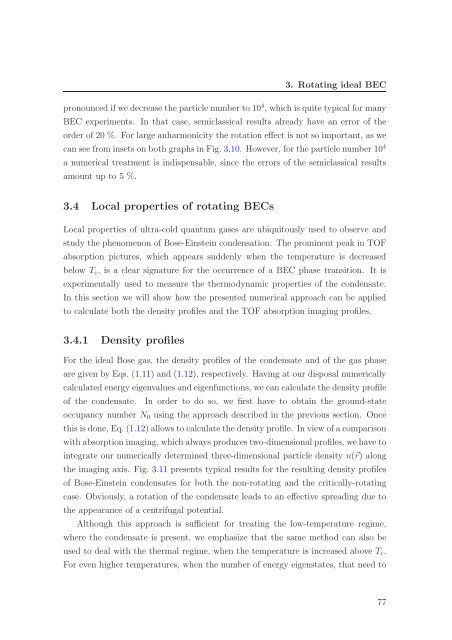PhD thesis in English
PhD thesis in English
PhD thesis in English
You also want an ePaper? Increase the reach of your titles
YUMPU automatically turns print PDFs into web optimized ePapers that Google loves.
3. Rotat<strong>in</strong>g ideal BECpronounced if we decrease the particle number to 10 4 , which is quite typical for manyBEC experiments. In that case, semiclassical results already have an error of theorder of 20 %. For large anharmonicity the rotation effect is not so important, as wecan see from <strong>in</strong>sets on both graphs <strong>in</strong> Fig. 3.10. However, for the particle number 10 4a numerical treatment is <strong>in</strong>dispensable, s<strong>in</strong>ce the errors of the semiclassical resultsamount up to 5 %.3.4 Local properties of rotat<strong>in</strong>g BECsLocal properties of ultra-cold quantum gases are ubiquitously used to observe andstudy the phenomenon of Bose-E<strong>in</strong>ste<strong>in</strong> condensation. The prom<strong>in</strong>ent peak <strong>in</strong> TOFabsorption pictures, which appears suddenly when the temperature is decreasedbelow T c , is a clear signature for the occurrence of a BEC phase transition. It isexperimentally used to measure the thermodynamic properties of the condensate.In this section we will show how the presented numerical approach can be appliedto calculate both the density profiles and the TOF absorption imag<strong>in</strong>g profiles.3.4.1 Density profilesFor the ideal Bose gas, the density profiles of the condensate and of the gas phaseare given by Eqs. (1.11) and (1.12), respectively. Hav<strong>in</strong>g at our disposal numericallycalculated energy eigenvalues and eigenfunctions, we can calculate the density profileof the condensate. In order to do so, we first have to obta<strong>in</strong> the ground-stateoccupancy number N 0 us<strong>in</strong>g the approach described <strong>in</strong> the previous section. Oncethis is done, Eq. (1.12) allows to calculate the density profile. In view of a comparisonwith absorption imag<strong>in</strong>g, which always produces two-dimensional profiles, we have to<strong>in</strong>tegrate our numerically determ<strong>in</strong>ed three-dimensional particle density n(⃗r) alongthe imag<strong>in</strong>g axis. Fig. 3.11 presents typical results for the result<strong>in</strong>g density profilesof Bose-E<strong>in</strong>ste<strong>in</strong> condensates for both the non-rotat<strong>in</strong>g and the critically-rotat<strong>in</strong>gcase. Obviously, a rotation of the condensate leads to an effective spread<strong>in</strong>g due tothe appearance of a centrifugal potential.Although this approach is sufficient for treat<strong>in</strong>g the low-temperature regime,where the condensate is present, we emphasize that the same method can also beused to deal with the thermal regime, when the temperature is <strong>in</strong>creased above T c .For even higher temperatures, when the number of energy eigenstates, that need to77
















